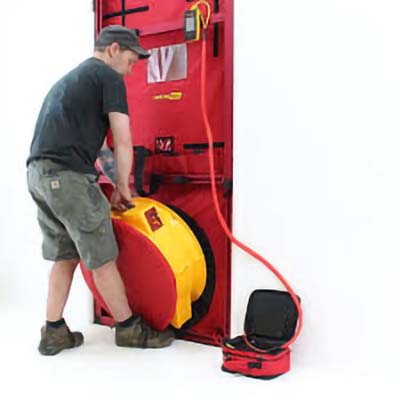Blower Door Test in Italy, TX | Certified Energy Testing
Anyone building a new home or multi-family unit in Italy, TX, is likely to require a blower door test to stay in compliance with the 2018 International Energy Conservation Code (IECC).
With a team of certified energy testers, we offer accurate and trustworthy blower door and duct leakage testing to help your project meet Texas energy code standards. Our specialists excel in detecting air leakage problems that impact energy efficiency, indoor air quality, and heating and cooling expenses. If you’re a builder, contractor, or homeowner, we provide reliable, affordable, and certified blower door testing in Italy, TX, and surrounding regions.

What Is a Blower Door Test?
- Energy efficiency – Air leaks in homes lead to wasted energy and higher electricity bills.
- Indoor air quality – Unsealed air leaks can introduce pollutants and allergens into your home.
- HVAC performance – Air leakage forces HVAC systems to work harder.
- Comfort levels – Excess air leakage causes drafts and uneven indoor temperatures.
How Does a Blower Door Test Work?
A blower door test utilizes a mounted fan on an exterior door to create a pressure variation between the inside and outside of a house. Using a pressure gauge, we can assess the amount of air entering through unsealed cracks, leaks, and small gaps. When a home has significant air leaks, sealing gaps and upgrading insulation may be necessary.

Do You Need a Blower Door Test in Italy, TX?
According to the 2018 IECC, newly built homes in Italy, TX must pass a blower door test to comply with energy efficiency standards.
You may also need a blower door test if:
✔ Your new home construction must successfully pass the final energy efficiency inspection.
✔ Your energy bills are high and you suspect excess air leakage.
✔ You experience drafts, uneven heating, or poor indoor air quality.
✔ You are applying for an energy efficiency rebate or certification.
When blower door testing is necessary, our experts offer efficient scheduling, rapid test results, and full energy compliance certification.

Texas Energy Code Requirements for Blower Door Testing
According to the 2018 IECC, Texas homes must comply with the following air tightness requirements.
- 3-5 (Air Changes Per Hour at 50 Pascals) depending on location.
- Homes exceeding this air leakage limit may require additional air sealing measures.
Furthermore, if any HVAC components, like ductwork or an air handler, are placed outside the conditioned space, a duct leakage test is also required.
Our Blower Door Testing Process
By scheduling a blower door test in Italy, TX, our certified team follows a comprehensive process to ensure compliance:
Step 1: Preparation
- All windows and doors are securely closed.
- HVAC systems and exhaust fans are turned off.
- A blower door fan is installed in the main entryway.
Step 2: Conducting the Test
- By pulling air out, the blower door fan depressurizes the home to imitate real-life air leakage.
- Sophisticated digital tools evaluate air infiltration rates and detect leakage spots.
Step 3: Test Report & Certification
- An extensive blower door test report is prepared to ensure compliance with energy standards.
- When needed, we guide you through air sealing improvements to ensure your home qualifies.
With our fast, skilled, and worry-free service, your project stays on track without delays.

Why Choose Us for Blower Door Testing in Italy, TX
By selecting our professionals for blower door testing in Italy, TX, you enjoy:
✔ Certified Energy Experts – Fully licensed and trained professionals.
✔ Fast Scheduling – We work around your project timeline.
✔ Same-Day Results – Receive a certified test report immediately.
✔ Affordable Rates – Competitive pricing with no hidden fees.
✔ Duct Leakage Testing Available – One-stop compliance for all Texas energy codes.

Schedule Your Blower Door Test in Italy, TX Today!
Need blower door testing in Italy, TX? We guarantee a seamless and worry-free service. Contact us today to arrange your test and ensure compliance with Texas energy standards.



